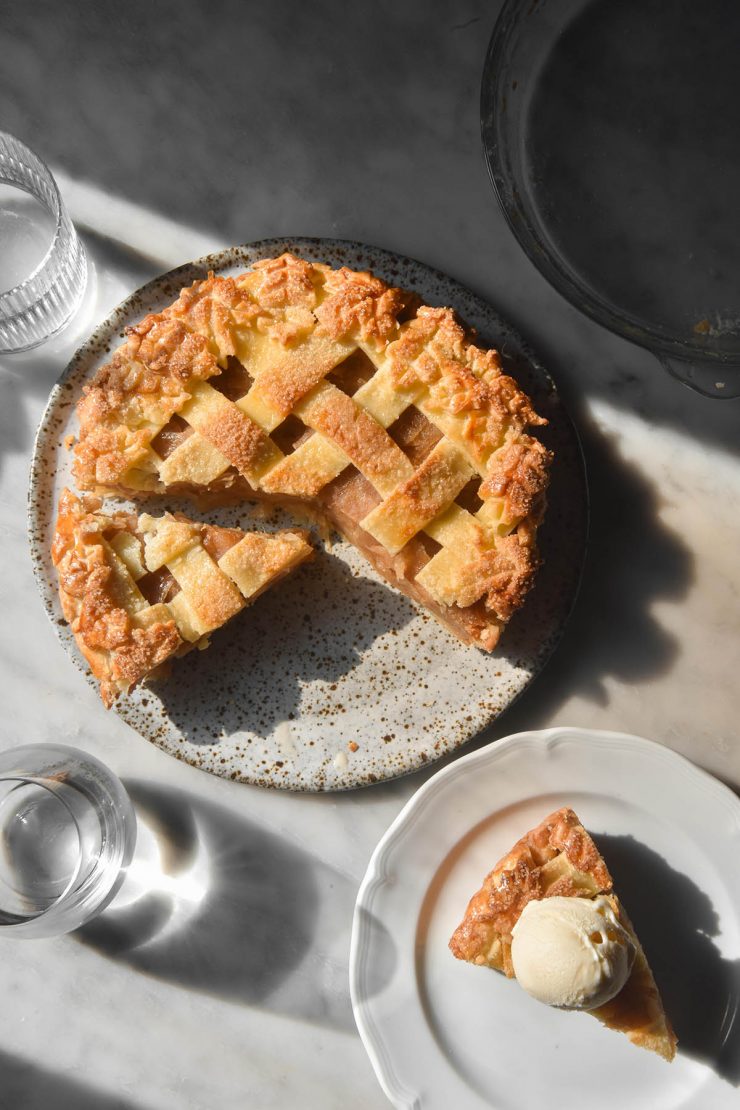
If I had to choose the one dessert I miss the most since my digestive system went haywire, it would be apple pie. I’ve developed gluten free croissants and low FODMAP Christmas pudding, but I figured apple pie was a lost cause. Until I discovered jicama, and this low FODMAP apple pie was born.
Low FODMAP ‘apple’ pie (gluten free)
So yeah, this low FODMAP apple pie contains no apple at all. It uses low FODMAP, low fructose jicama that has been flavoured with sugar, lemon juice and cinnamon. This gives it that classic apple pie flavour without the fructose content.
As for the pastry, you have a number of options. I have lots of gluten free pastry recipes on my website – ranging from an easy enriched sour cream pastry to grain free pastry. You can use whichever recipe works best for your dietary needs.
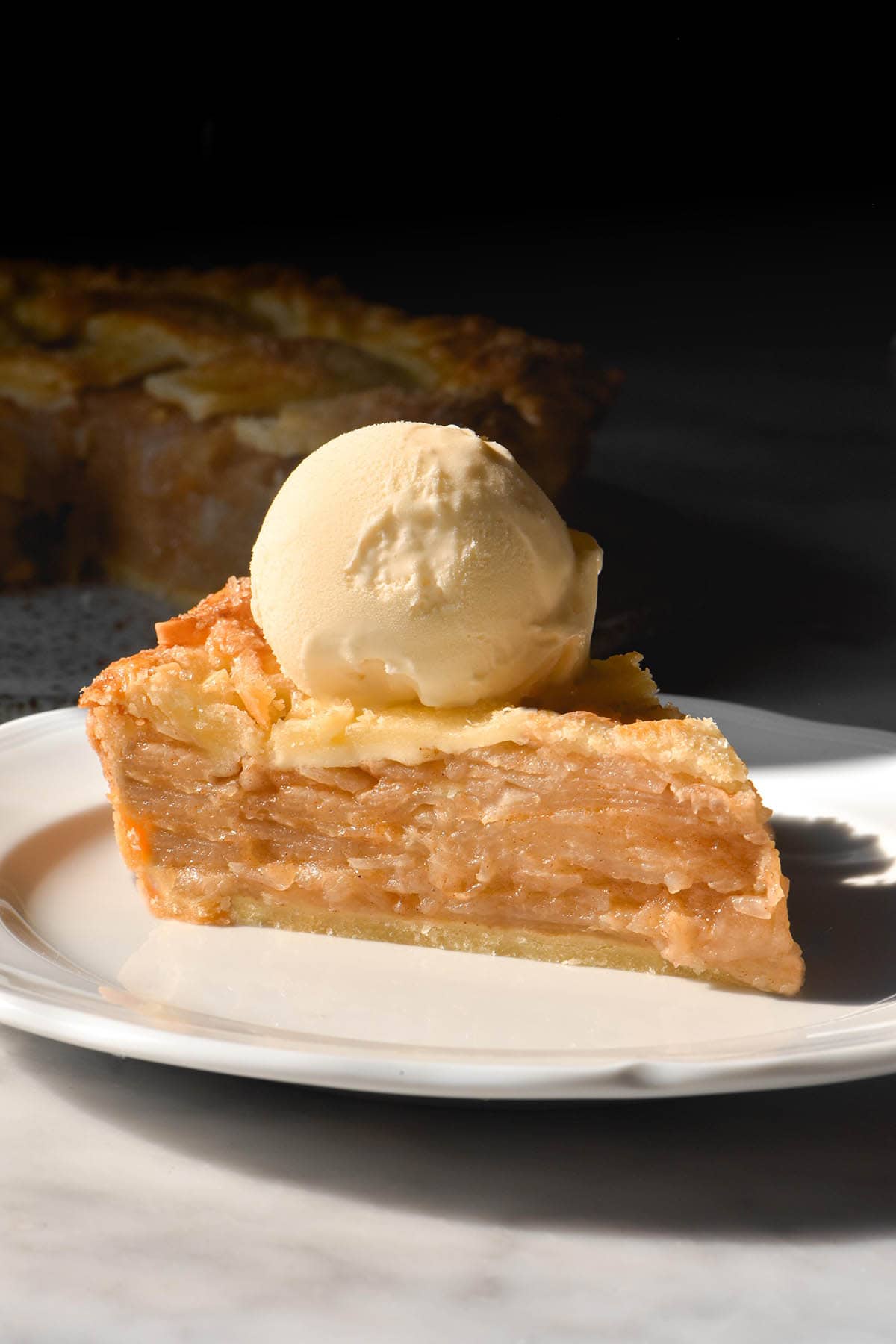
What is jicama?
Jicama is a root vegetable that has a bulbous shape and a light brown papery skin. Jicamas taste like a savoury apple, or a cross between potatoes, apples and water chestnuts. They have a crunchy, snappy and refreshing bite and can be eaten raw or cooked.
Jicamas are sold under a variety of names, including yam bean, Mexican potato or Mexican turnip. They are native to Mexico and South America.
In Australia (and Melbourne specifically) I have managed to buy them at Footscray market and in Springvale. They are slightly more niche here (and not cheap!) but they make a great apple alternative for a special occasion.

Is jicama low FODMAP?
Monash says that Jicama is low FODMAP in serves of 75g per person. However, they only become moderate for fructans in servings of 244g or more (as of July 2025). This suggests there is considerable wiggle room as to what constitutes a low FODMAP serve. As always, assess your own tolerance and eat what works for you.
What do these thresholds mean for this pie, though? If you slice the pie into 8 serves, each serve contains 125g jicama. This is more than the minimum threshold that Monash has, but still within a low FODMAP range up to 244g. If jicama works well for you, you could have 2 slices (or slightly less) before the jicama becomes moderate in fructans.
If you’re being extra cautious, 1/2 a slice contains approximately 62.5g jicama. This is a holiday dish though, and it’s still a far better option than an apple pie for those who malabsorb fructose.
On that note, it is worth noting that apples and jicama contain different FODMAPs. Small to medium serves of apple contain fructose and large serves both fructose and sorbitol, whereas larger serves of jicama contain fructans. Consider which FODMAPs are an issue for you (post elimination phase) and adjust accordingly. It might even end up that a traditional apple pie is better for you personally.
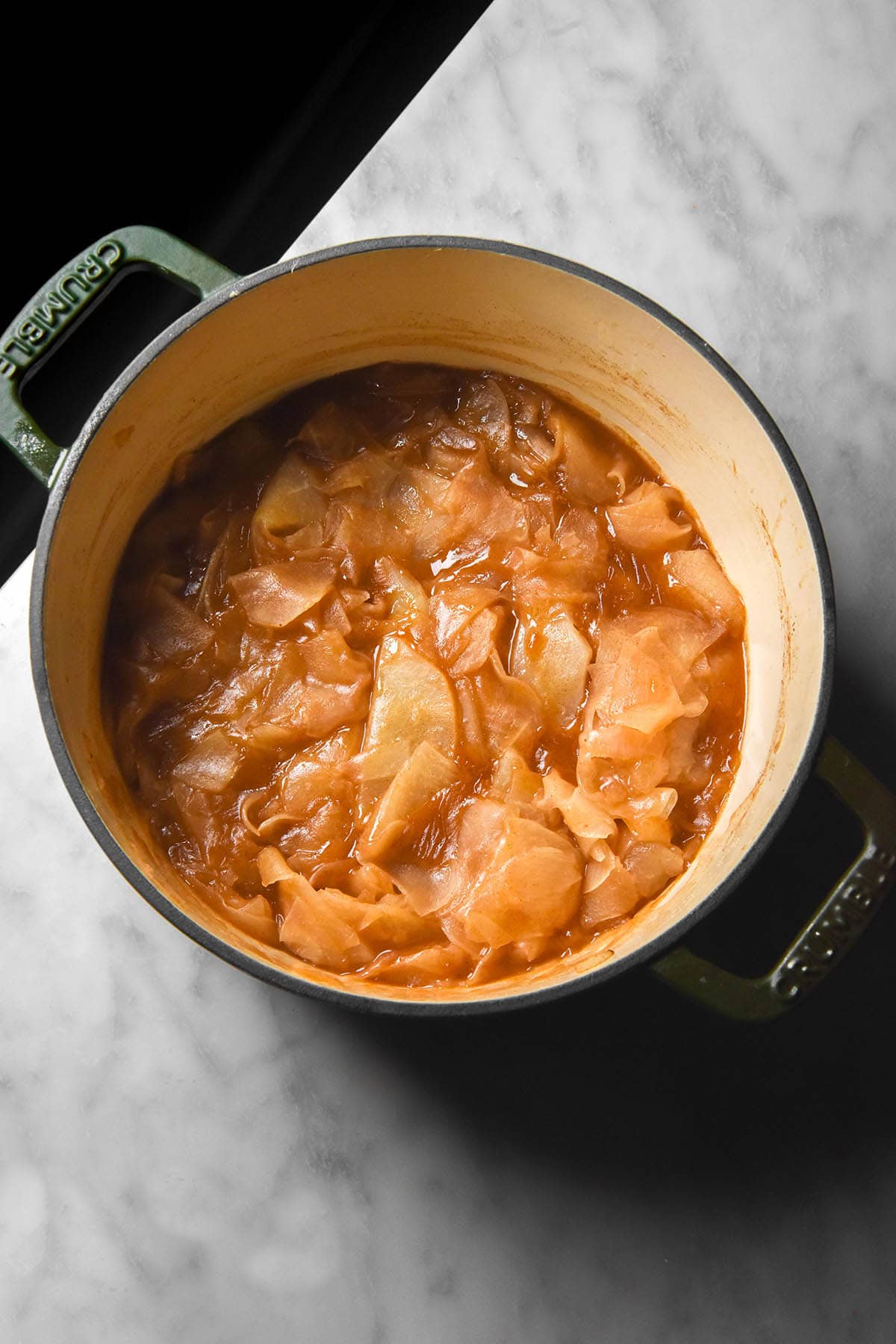
Are apples low FODMAP?
Apples have a considerably lower FODMAP threshold than jicama. Granny Smith apples (peeled) have a low FODMAP threshold of 25g or approximately 1 tablespoon per serving. They become moderate for sorbitol at 39g.
Pink Lady apples (peeled) have a low FODMAP serving of 23g. At 31g, they become moderate for fructose and sorbitol.
I wanted to develop an apple pie recipe that I could eat a slice or two of without feeling terrible. This is why the recipe uses jicama instead of apples.
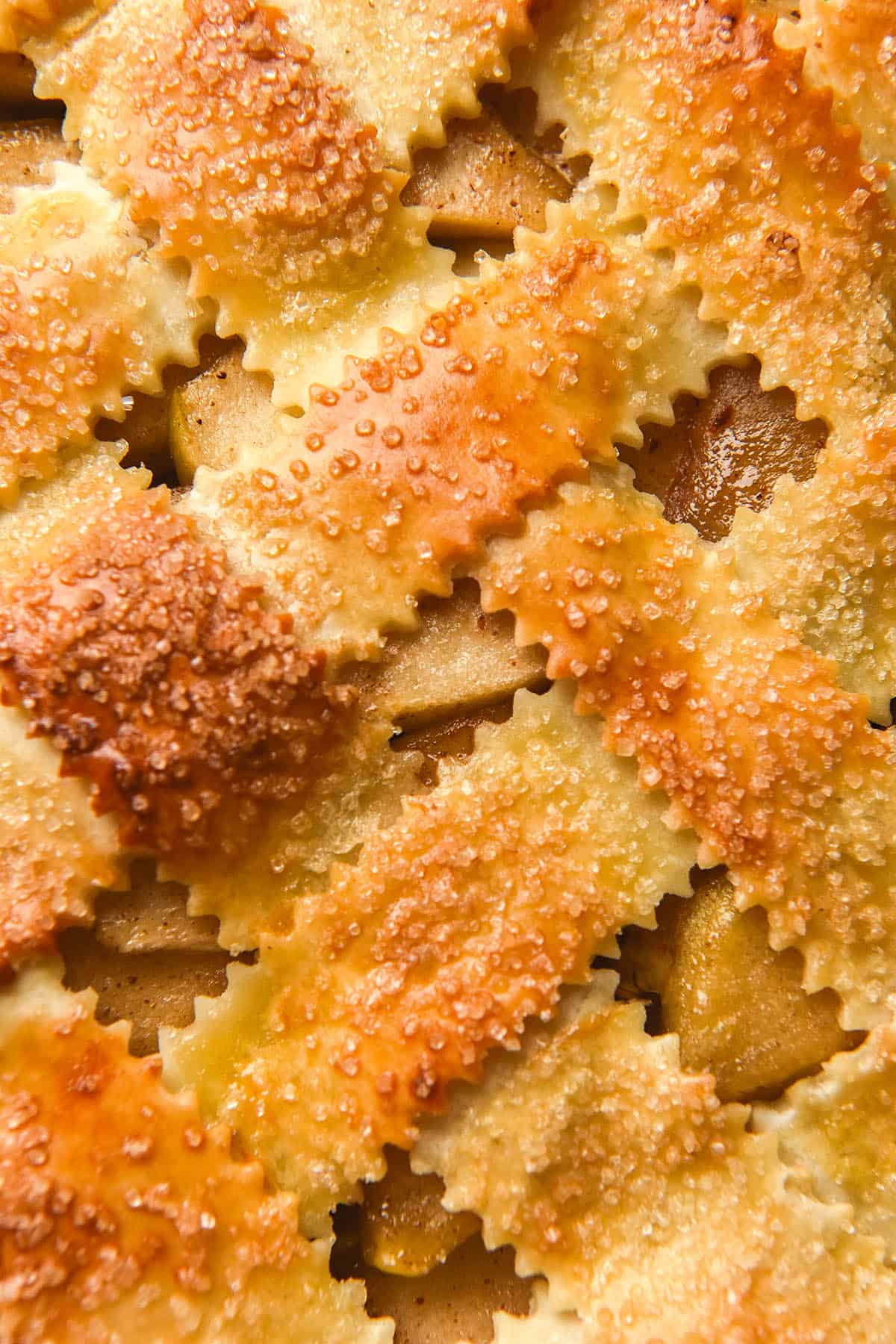
Tips for your low FODMAP apple pie
The most important tip I can give you is that jicama needs to be mandolined (or very sliced finely at the very least) and cooked extremely thoroughly in order to replicate apple. It is a very hardy vegetable and can be too fibrous and firm to taste like apple if it isn’t prepared properly.
Unlike apple, the jicama will not continue to soften as the pie cooks. This is why it is so important to slice it thinly and to cook it really well before you assemble your pie.
Personally, I like to prepare my apple filling ahead. It needs to be cool in order for the pastry top to stay firm as you assemble it. This is really most important if you intend to decorate the pie or do a lattice top. However, it is still helpful to cool the filling regardless. It means you don’t have to rush, and the pastry is less likely to bleed butter.
One last tip: this recipe is designed around a 1.2 litre capacity pie dish (24cm inside the flared rim, 21cm at the base). You cannot use any old size dish and expect the same result. A bigger pie dish will result in a large but short and squat pie that will probably burn with the timings in the recipe card. A smaller pie dish will result in a taller pie that will not fit all the fillings.
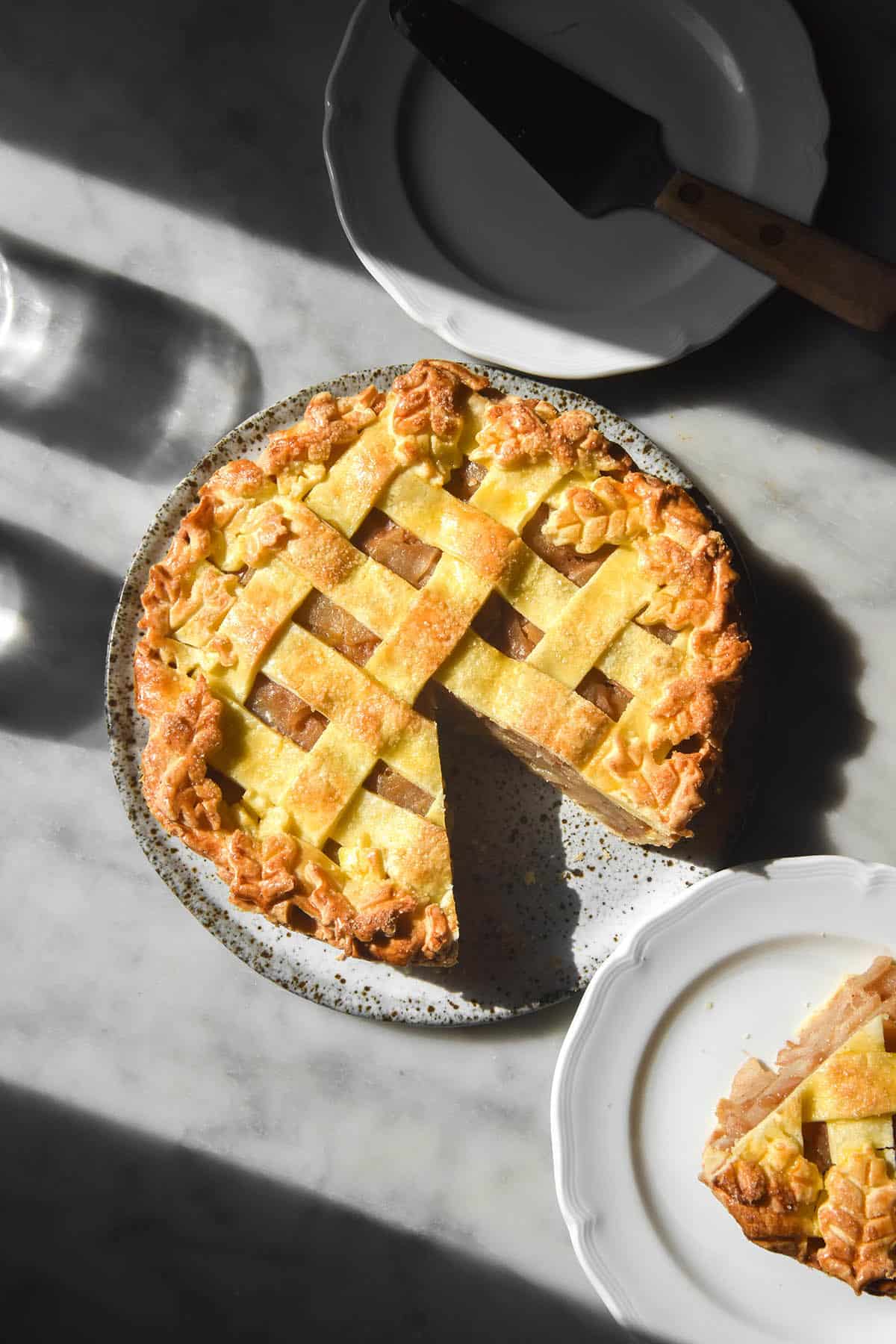
Notes on the gluten free pie dough
This pie dough makes enough for a base, lid and generous amount of decorations. I wanted to ensure nobody would be left without enough pastry to complete their pie. I love adding a wreath of pastry decorations around the edge of the pie, but it is optional. You can freeze leftover pastry or bake it up as little biscuits.
To bake the extra pastry, I give each piece a light spray with oil and then bake for 6-10 minutes. As an insurance policy, I like to keep the piece of foil on the top rack of the oven as per the recipe. This is optional, but it does help ensure they don’t burn.
You can use a simple pie top with this crust or you can make a lattice top. It’s easier than it seems, I promise. I have found the best way to learn is to watch, so here is a video demonstrating how to make a lattice crust. The butter in their pastry is too chunky for a gluten free dough, so ignore that aspect.
This pie crust uses lactose free sour cream to keep the overall FODMAP content down. If you are fine with lactose, you can use regular sour cream. If lactose free sour cream is not available to you, you can make your own lactose free sour cream. It is a bit of an effort, but fun and easy. If you can’t: take some lactase with the pie. That is essentially what lactose free dairy is.
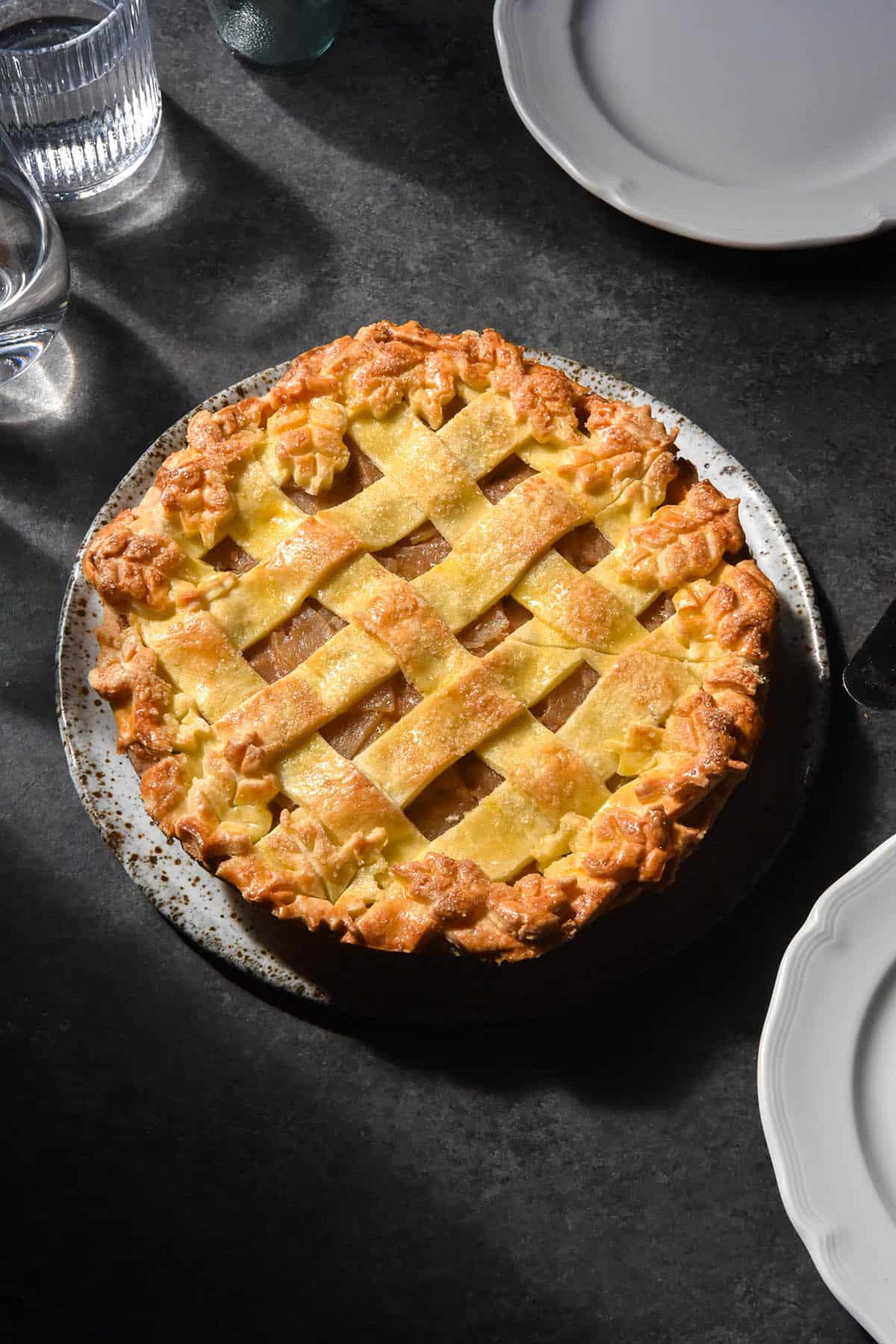
Can I make this gluten free pie dough without xanthan gum?
Yes, you can (but there are caveats). This pastry uses 1/2 – 1 teaspoon xantham gum. I have tried it with both quantities and it was easy enough to use. Personally, I try not to use too much xanthan gum as it doesn’t agree with me. I also find it gives baked goods a slightly slimy mouthfeel.
The yoghurt version of this pastry recipe uses psyllium husk powder as a binder. I recommend using 2-4 teaspoons of the powder (which is stronger than the flakes). I daresay lattice work will be slightly more difficult, although not impossible. With that in mind, I would suggest sticking to a solid pie top for beginners.

Troubleshooting your gluten free pie dough
Having worked on gluten free pastry recipes for years, I have a fairly good handle on working with it. I realise some people aren’t making pies every day, so I wanted to share my favourite tips for working with gluten free pie dough.
- Use just enough water to bring the dough into a smooth ball without making it wet. Wet dough is a nightmare to roll out and uses way too much flour. It’s ok if the dough feels a bit dry but pulls together into a ball. It is filled with butter and sour cream, so it won’t taste dry.
- Don’t try to work with pastry that is warm. Soft butter will not cooperate. If your pastry is sticking to the bench, stop and put it in the fridge.
- Anecdotally, I found that pastry dough made on the same day as baking was easier to roll out.
- If your pastry is cracking every time you try to roll it out, laminate it a couple of times. This makes pastry much easier to work with, as it distributes the butter for a more flexible dough. There are visual instructions in this post.
- Some of my lattice pieces broke when I was assembling the pie. This is to be expected. Simply wet the pieces and patch them back together. Also see the above on laminating the pastry to make it easier to handle.
- Pastry will also crack when it is too cold. If it’s hard to roll and continously falling apart, allow it to warm up a little before proceeding. Over time you’ll learn what temperature is perfect for rollling.
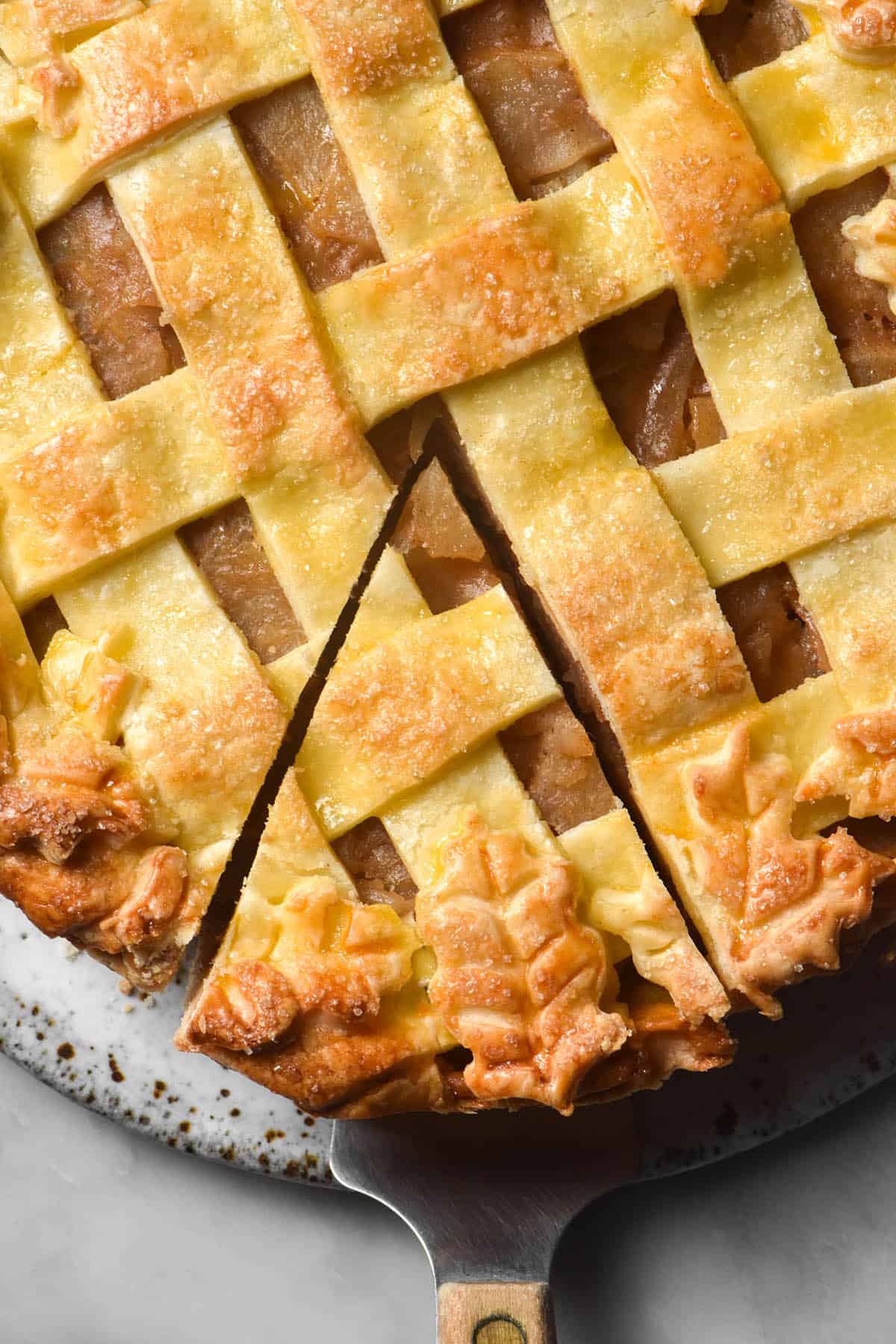
Can I use store bought gluten free pie dough instead?
If you would prefer to skip the hassle of making pastry, sure! However, there are a few FODMAP considerations. Be sure to choose a brand without inulin (can be called ‘fibres’ in the ingredients list) chickpea flour, soy flour or other legume flours. This is not an exhaustive list, so cross check anything you aren’t sure of.
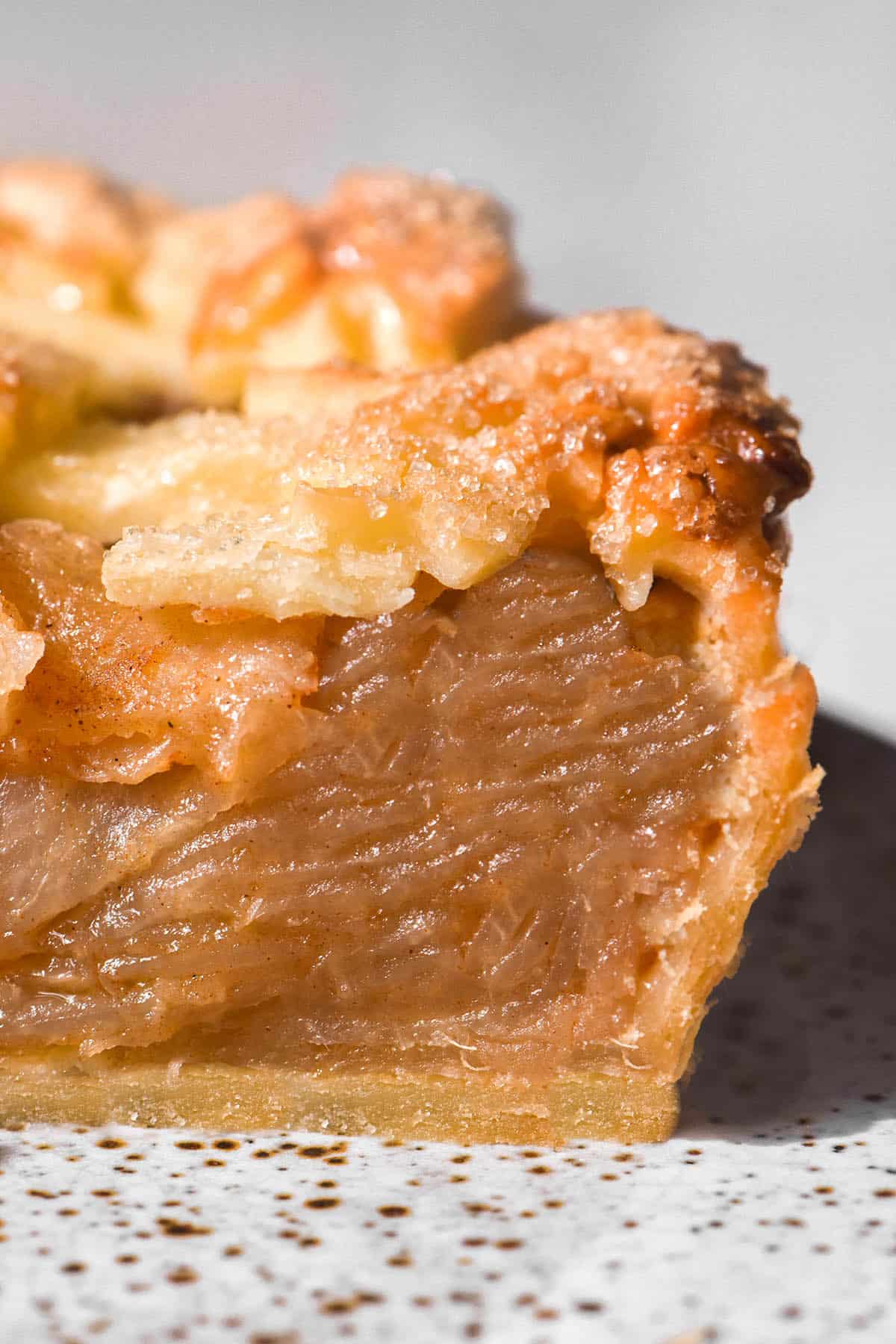
More low FODMAP dessert recipes
- Easy gluten free chocolate cake (plus a vegan version)
- Lactose free creme caramel
- Gluten free vegan cinnamon rolls without yeast
- Gluten free mug cake
- Fruit free, gluten free mince pies

Low FODMAP ‘apple’ pie (gluten free)
Equipment
- 1 X 1.2 litre capacity pie dish (24cm inside the flared rim, 21cm at the base)
Ingredients
For the apple filling:
- 1 kg jicama peeled and mandolined very finely (I buy about 1.3kg jicama to account for the volume loss from peeling)
- 1/2 teaspoon baking soda
- 75 g butter salted or unsalted
- 125 ml (1/2 cup)* lemon juice
- 220 g (1 cup)* white sugar
- 2 teaspoons cinnamon powder
- 20 g corn starch
- Pinch of salt
For the pastry:
- 240 g (1 1/2 cups)* fine white rice flour
- 90 g (3/4 cup)* tapioca flour see notes
- 50 g-75g icing sugar see notes
- Pinch of fine salt
- 2.5g – 5g (1/2 – 1 teaspoon) xanthan gum
- 175 g butter cold and cubed (salted or unsalted)
- 100 g lactose free sour cream
- 60 ml (1/4 cup)* Ice water to bring the dough together I needed
- 60 ml (1/4 cup)* water
For rolling and baking:
- Tapioca flour, for rolling
- 1 large egg, for egg wash
- Raw sugar, to sprinkle over the pastry (optional)
Instructions
To make the apple filling:
- Peel the jicama and use a mandoline on the finest or second finest second to slice the jicama into very thin pieces. Each slice should be slightly translucent but still whole – this is how thin you want it.
- Bring a large pot of water about 2/3 full to the boil. Once it is boiling, add the sliced jicama and stir to ensure all the jicama is submerged.
- Sprinkle over the baking soda, keeping in mind that it will bubble a little. Stir to combine. The baking soda helps tenderise the jicama and also gives it a cooked apple colour. Any baking soda flavour should be neutralised by the lemon in the next stage.
- Continue to cook for 15-20 minutes or until the jicama looks visibly softened. Don’t worry too much if jicama slices break up – I promise it won’t turn into puree even if they do.
- Once the jicama is cooked, strain it over the sink.
- Return the pot to a low medium heat. Add the butter and allow it to melt, then add the lemon juice, sugar and cinnamon. Stir to combine, then add the jicama back into the pot.
- Cook for around 5 minutes or until it starts to bubble. Taste the sauce and adjust according to your preferences.
- Mix the water and corn starch together in a small bowl until it becomes a smooth milky liquid. Pour this mixture over the jicama and stir to combine. The mixture should become glossy, slightly opaque and thicken up quickly. Allow it to cook for a minute or two until it reaches your desired thickness. Keep in mind that it will thicken as it cools. Set aside to cool.
To make the pastry:
- Start by ensuring that all your liquid ingredients are cold.
- Mix the flours, icing sugar, salt and xanthan gum together in a large mixing bowl. Add the cubes of cold butter and coat them with the flour mix. Use your fingertips to gently rub the butter into the flour mixture until it resembles wet sand.
- Add the sour cream in dollops and stir to combine. Add half the ice water and get your hands in there to gently incorporate the water and form a ball of dough. Add the remaining water if needed, and extra if required. The dough should just come together in a ball without any dry bits on the bottom of the bowl.
- Tightly wrap the dough in a beeswax wrap or cling film and place in the fridge for 30 minutes (longer in hot climates). Your pastry is then ready to roll out and use.
To assemble the pie:
- Preheat the oven to 180C/356F. Place one oven rack near the bottom of the oven and one right at the top. This top rack will house a piece of foil to stop the pastry from over baking.
- Take half the block of pastry and place it on a liberally floured sheet of baking paper. I use tapioca flour.
- Gently roll the dough out with a rolling pin, stopping every couple of rolls to flour both sides of the dough. ‘Turn’ the dough regularly (pick it up and flip it over) to prevent it from sticking. If at any point the dough becomes soft and difficult to work with, place it flat in the fridge or freezer for a few minutes.
- Once you have rolled it out to a couple of sizes larger than the pie plate, invert the pie plate gently in the centre of the pastry dough in whatever position maximises pastry overhang.
- Use one hand to pull a corner of the baking paper towards you, and slide the other underneath the baking paper directly in the centre of the pie dish. Flip the dish, letting the pastry fall into it.
- Don’t stretch the pastry into the dish – be generous with letting it fall into the dish. Patch up any tears as necessary, and then trim excessive overhang, redistributing it to places that may have none.
- Once you’re happy with how the pie dough is sitting, fold the tops of the pastry over themselves (outwards towards the pie dish) to create a smooth pie edge. This will create a flat and even pie edge, which is helpful when you’re putting the pastry lid on. It also just looks neater.
- Scrunch up a piece of large baking paper and place it into the pie dish. Ideally, some paper will hang over the edges – this will protect them from over browning during the blind baking time.
- Gently fill the pie with your pie weights. I really recommend using enough weights to go right up the edges of the pastry – this pastry easily buckles in. I use dried chickpeas and rice for my pie weights and they go right up to the edge of the pie dish.
- Place a large piece of foil flat on the top rack of the oven, then place the pie in the oven on the bottom rack. Bake for 30 minutes. Take the pie out of the oven and very gently remove the pie weights and baking paper, noting that they will be extremely hot (don’t put them in something ceramic, and don’t handle the bowl while they cool).
- Gently brush the pie crust (sides, base and top) with egg wash and return to the oven for 10 minutes. Set aside to cool.
- Roll out the second half of the pastry using the same method as you did for the pastry base.
- You can either make a complete lid to cover the whole pie or create a lattice top. There is a link in the body of the post to a visual demonstration on latticing.
- If you’re making them, make the pastry decorations while you’re at it.
- Gently pour the apple filling into the pie and flatten the top. Lightly brush the cooked edges with egg wash, and begin placing the pastry on top, pressing gently to adhere. Trim any excessive pieces and press them down onto the cooked pastry base to adhere. Brush the top with egg wash, then sprinkle over a little raw sugar if you want to.
- Return to the oven for 30 minutes, finishing with the grill function for extra colour if necessary.
- You can serve this pie hot or cold and it keeps well in the fridge for at least a few days.
Notes
- If you slice the pie into 8 serves, each serve contains 125g jicama. This is more than the minimum threshold that Monash has, but still within a low FODMAP range up to 244g. If jicama works well for you, you could have 2 slices (or slightly less) before the jicama becomes moderate in fructans.
- If you’re being extra cautious, 1/2 a slice contains approximately 62.5g jicama. This is a holiday dish, though, and it’s still a far better option than an apple pie for those who malabsorb fructose.
- On that note, it is worth noting that apples and jicama contain different FODMAPs. Larger serves of apple contain fructose and sorbitol, whereas larger serves of jicama contain fructans. Consider which FODMAPs are an issue for you (post elimination phase) and adjust accordingly. It might even end up that a traditional apple pie is better for you personally.
- This recipe has enough pastry to make the base, a top and generous decorations. You can freeze leftovers or bake them up as little biscuits. I spray mine with oil and bake for 6-10 minutes.
- Use sugar to taste in both the pastry and the ‘apples’. I used regular icing sugar in the pastry, which is cut with tapioca flour. If you use pure icing sugar (which is 100% sugar) you might need less.

No Comments